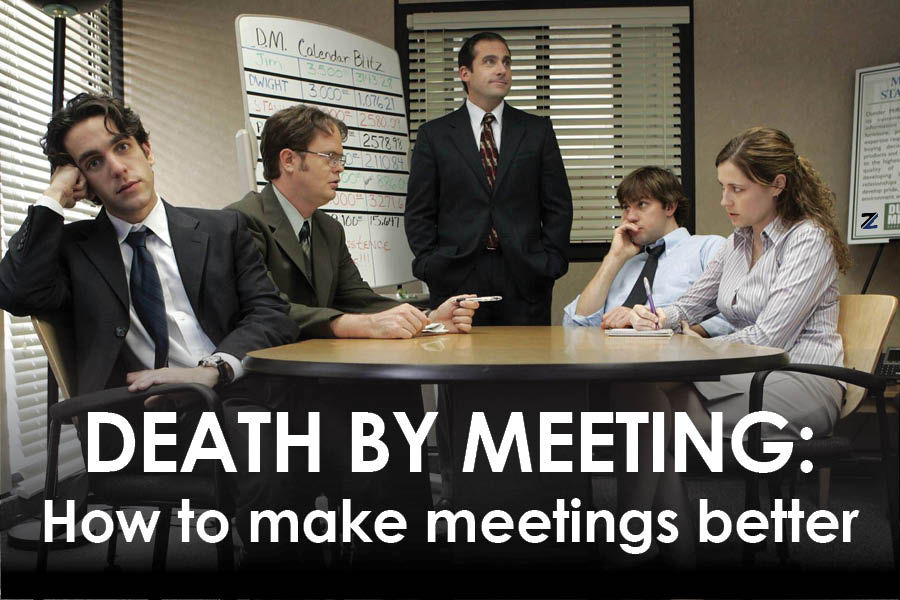
“If you had to identify in one word the reason why the human race has not achieved – and will not achieve — its full potential, that word would be… meetings.”
– Dave Berry, Pulitzer Prize Winner
We all have our share of anecdotes and experiences when it comes to unnecessary, inefficient, and at times, bewildering meetings. Yet, despite the widespread experience of meeting fatigue, many leaders and organizations I’ve collaborated with appear to be caught in an endless cycle of unproductive meetings. Some leaders may not fully grasp the extent to which they’re undermining productivity with excessive meetings. Even for those leaders who acknowledge the need to cut back on meetings, developing an effective approach for their teams can often feel like navigating a labyrinth.
How often should you schedule meetings? What’s the optimal structure for a meeting? When is the best time of day to convene one? And who should be included?
These are just a few of the questions that must be addressed for each meeting you organize. It’s no surprise that meetings often lack a well-defined structure when there are so many factors to consider.
3 Common Pitfalls for Meetings
Every organization adheres to certain meeting norms, often established by their founders or adopted from past experiences in various workplaces. The issue arises when we fail to reassess these norms, even when they become counterproductive.
From my experience collaborating with businesses across diverse industries, I’ve observed several recurring pitfalls in our approach to meetings:
1) Filling the meeting room with spectators.
One common pitfall is inviting individuals who do not necessarily need to be present. For instance, including junior employees to merely listen in or receive instructions when their involvement may not be essential. Another common occurrence is inviting people for political or strategic positioning, rather than genuine contribution to the meeting’s objectives. Addressing these motives in scheduling meetings is crucial.
2) Winging it… intentionally or unintentionally.
How often have you scheduled a meeting to discuss a topic, only to get caught up in other tasks, leaving you to scramble for last-minute preparation moments before the meeting begins? Effective meetings rely heavily on thorough planning and preparation. This holds especially true for recurring meetings that become routine. Taking the time to strategically consider the meeting’s purpose, goals, and desired outcomes is vital.
3) Treating meetings like a weekly report or one-person TED talk.
Many meetings are convened primarily for gathering updates or for a leader to issue instructions or assignments for new initiatives. However, much of this information sharing and direction could be efficiently handled via email. Meetings, on the other hand, should serve as a platform for collaboration, discussion, and collective problem-solving. They offer a unique opportunity for a group to brainstorm, share ideas, and work together to find solutions.
Creative Ideas and Approaches to Make Meetings More Life-Giving
The topic of how to run an effective meeting has become an increasingly important topic, and there’s no shortage of advice. In an attempt to make effective change more accessible, I wanted to highlight two particular resources.
Patrick Lencioni’s Death by Meeting is one of my favorite books on how to run the right meetings the right way. The book is a must-read for leaders who spend an unnecessary amount of time in fruitless meetings. Last month, organizational psychologist Adam Grant put out a fascinating podcast episode entitled, Why Meetings Suck and How to Fix Them. In it, he makes the point that it’s not the meetings in and of themselves that are the biggest issue for productivity, it’s the quality of the meeting that makes the biggest difference.
Here are a few of my favorite creative ideas and approaches that were highlighted in these resources:
- Set your default meeting time to an odd or shorter length. Instead of the default 30-minute or one-hour meeting, try a 16-minute meeting or end one-hour meetings at 50 minutes to give people time to transition to their next task.
- Organize and structure your regular meetings according to their type. Perhaps one of the best take-outs from Death By Meeting is learning how to categorize meetings according to duration and objective. Lencioni offers practical suggestions for daily, weekly, monthly, and quarterly meetings.
- Host stand-up meetings – When people are standing, they tend to get to their main points faster. As a result, stand-up meetings are typically shorter than seated meetings, but just as productive. It’s also harder to multitask while standing.
- Don’t host meetings on certain days. If possible, reserve specific days for deep work and productivity, avoiding meetings on those days.
- Put a policy in place where meetings with a certain number of people require approval. One of the ways to avoid the pitfall of inviting too many people to a meeting. Microsoft Japan put a policy in place where meetings with more than five attendees required special approval. This created the pause that allowed people to ask, “Do I really need this meeting?”
- Create a question-driven agenda. One of the ways to avoid the leader being a talking head is to create an agenda that encourages voice and seeks input. Frame your meeting agenda as a series of questions to be answered, rather than topics for discussion. This facilitates an inclusive dialogue, encouraging input and discouraging the leader from dominating the conversation.
- Rotate meeting facilitators. You can promote diverse voices and encourage experimentation by rotating meeting leaders. This not only enhances leadership development but also fosters different perspectives.
No matter what specific practices you choose, it’s important to be intentional about your meetings and to talk about them candidly. If you’re going to have a meeting to discuss how to improve your meeting process, try incorporating some of these ideas. Your employees (and your bottom line) will thank you!
By Kent Wilson
